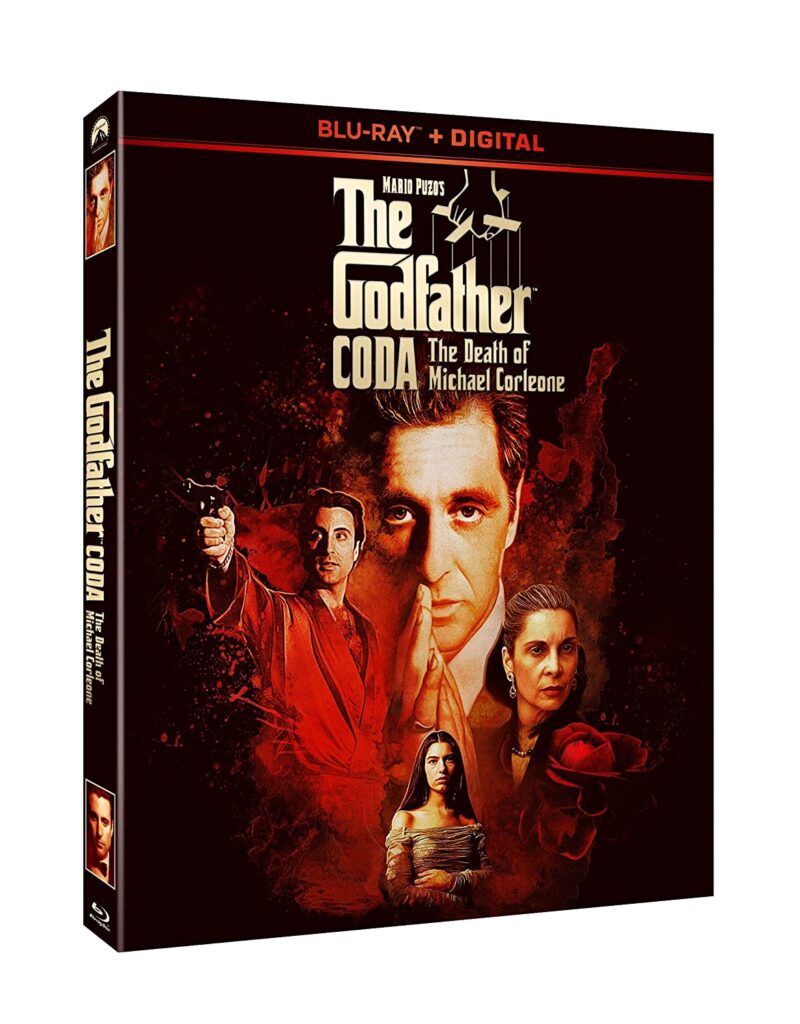
Timed to coincide with the 30th anniversary of the The Godfather Part III , director/producer/co-writer Francis Ford Coppola recut the film, making changes to the opening, the closing, and scenes throughout, creating Mario Puzo’s The Godfather, Coda: The Death of Michael Corleone, which runs four minutes shorter. I saw Part III when it was originally released and while I agreed with the general consensus that it didn’t reach the same heights as the previous two installments, I found that it told an interesting story with its incorporation of historical elements about the Vatican and the mob. I haven’t seen Part III since 2008 when The Godfather – The Coppola Restoration came out on Blu-ray and won’t be making a thorough comparison between the two.
The film opens in the late 1970s with Michael Corleone (Al Pacino) looking to buy the Vatican’s shares in Immobiliare, an international real estate holding company, in exchange for covering most of the Vatican Bank’s $769 million loss. Michael wants onto the company’s board to legitimatize his family business, which he had been running since taking over for his ailing father and made decisions at a great cost to himself and those close to him. He no longer wields power like he used to having turned over his interests to Joey Zasa (Joe Mantenga) but is still a respected figure. As with the previous films, Michael has to juggle family matters and business matters, which continue to overlap. At a party held in his honor, Michael has meetings regarding both matters, which will intersect throughout the film. His son Anthony (Franc D’Ambrosio) wants to give up on law school and pursue being an opera singer. His mother Kay (Diane Keaton) supports him. Joey Zasa and his underling Vincent Mancini (Andy Garcia), Sonny’s illegitimate son, are in conflict. Michael mediates, but Vincent exacerbates matters, which frustrates yet also impresses his uncle.
Michael finds business, whether legal or illegal, doesn’t run smoothly. He learns there are parties in Europe that don’t want to see the Immobiliare deal go through. At home, the other families want in on the deal, but Michael chooses to pay them off what was made from the sale of the casinos, except Zasa, who is insulted and retaliates. A mob war is unleashed in New York and makes its way to Italy. No one is safe, not even the Pope, as the casualties start to pile up.
Though sacrilege to many, I enjoyed Coppola and Puzo’s last chapter in the life of Michael Corleone as he battled the different forces against him. Revisiting characters were highlights. It was good to see him and Kay talk about their love for each other, and to see how much of a role Connie (Talia Shire) has in the business. It was unfortunate they couldn’t get Robert Duvall to return as Tom Hagen, but George Hamilton did a fine job as Michael’s lawyer, B.J. Harrison. Unfortunately, Sofia Coppola didn’t rise to the level of the actors around her, but the amount of criticism she received, including blame for the film’s box-office failure, was excessive.
The video has been given a 1080p/MPEG-4 AVC encoded transfer displayed in the film’s original aspect ratio of 1.85:1 that does a marvelous job in capturing legendary cinematographer Gordon Willis’ work. Earth tones appear with rich saturation, such as the brown tones that surround Michael and the Cardinal during the opening meeting at St. Patrick’s Cathedral and the golden-tinged browns in Michael’s office when he talks to Anthony. Other colors are vibrant too, as seen during the party honoring Michael and the opera Anthony appears in. The blacks are very inky and the shadow delineation is strong. Film grain is apparent, and the image showcases depth and fine texture detail.
The audio is available in Dolby True HD 5.1. Dialogue is consistently clear. The dynamic range is wide as demonstrated on the quiet end during the opening scene as Michael and the Cardinal speak softly with an echo indicating how cavernous the room is. The loud end is best revealed during the helicopter attack scene, as the surrounds fill with engine noise and gunfire, and the subwoofer delivers solid bass support. Composer Carmine Coppola’s score envelopes the viewer as does slight ambient effects. There was no sign of hiss or defect.
Of course, comparisons to The Godfather are inevitable, but that’s a standard a great number of films fail. Mario Puzo’s The Godfather, Coda: The Death of Michael Corleone may have had more success if the family at the center of the story wasn’t named “Corleone,” but it’s not as bad as its reputation and offers a fresh take on the mob drama. The Blu-ray’s high-def presentation is engaging. It’s only lacking in special features because the “Introduction from Francis Ford Coppola” (HD, 2 min) is much to brief. This new version deserves a commentary track on his thoughts behind the changes.